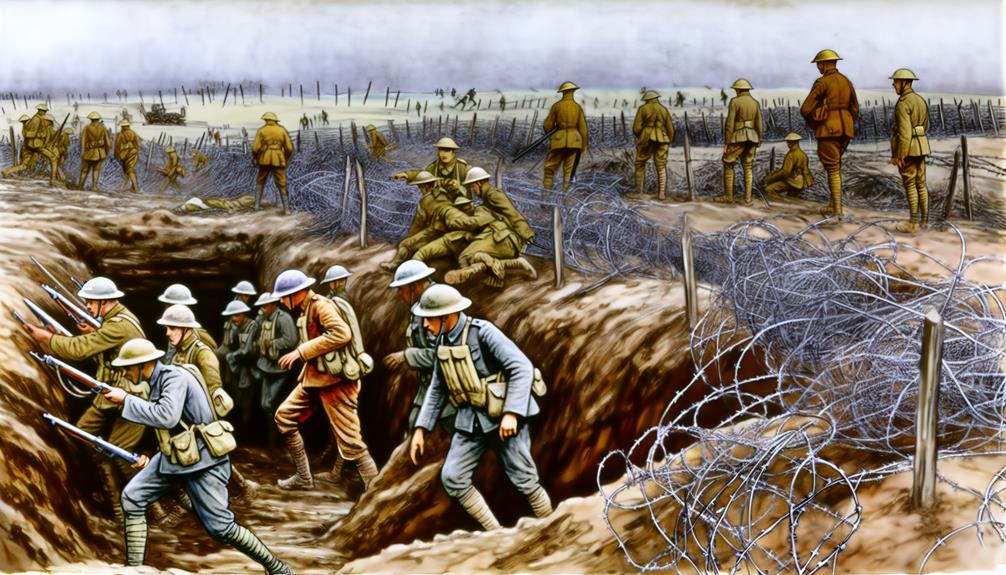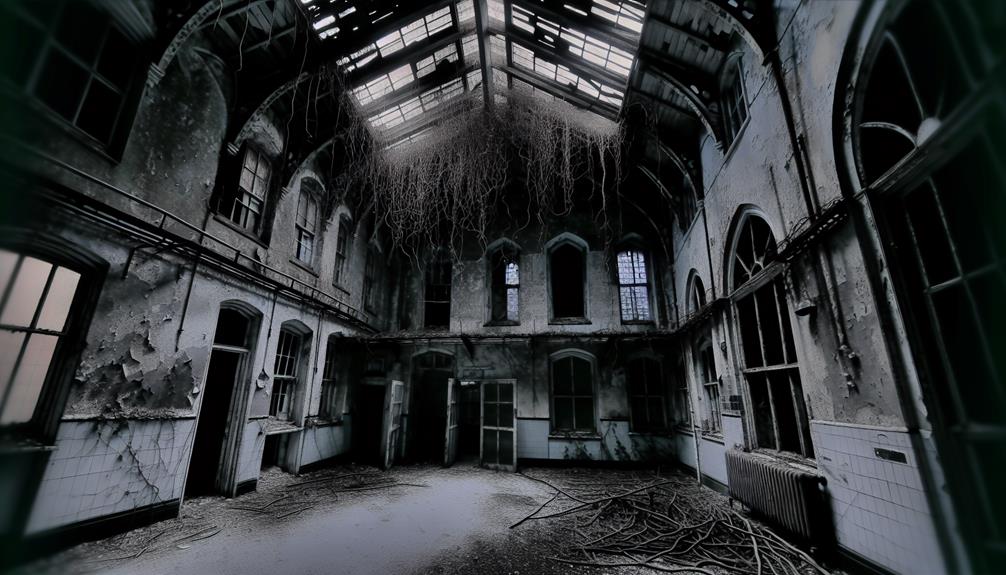The Battle of Verdun, often referred to as the longest and most grueling battle of World War I, holds a unique position in the annals of military history. This protracted conflict between German and French forces offers a compelling narrative of endurance, strategic acumen, and the human toll of warfare. As the battle unfolded over months of brutal combat, it revealed not only the complexities of trench warfare but also the resilience and determination of those caught in its grip. Exploring the intricacies of Verdun's landscape and the decisions made by military leaders during this relentless battle provides a fascinating insight into the challenges faced on both sides.
Key Takeaways
- Verdun battle lasted from February to December 1916.
- Intense German offensive aimed to break French morale.
- French defense focused on resilience and strategic fortifications.
- Unprecedented artillery bombardments caused immense devastation.
- Battle highlighted leadership impact on strategic decisions and outcomes.
Strategic Importance of Verdun
Analyzing the strategic importance of Verdun during World War I reveals its pivotal role in the conflict's broader military objectives. One key aspect was the tactical maneuvers undertaken by both the German and French forces in an attempt to gain control of the city. Verdun's location near the French-German border made it a critical point for both sides. The Germans viewed capturing Verdun as a way to weaken French morale and potentially force them into a negotiated peace, while the French saw holding Verdun as a matter of national pride and strategic necessity.
Furthermore, Verdun's significance extended to its impact on supply lines. The city's location along the Meuse River made it an essential transportation hub for the French army. Control of Verdun meant control of these crucial supply routes, allowing the French to maintain their forces in the region and continue the fight against the German offensive. On the other hand, the Germans recognized that cutting off these supply lines would weaken the French position and potentially lead to a breakthrough in their favor.
Fortifications and Terrain
The fortifications and challenging terrain surrounding Verdun played a pivotal role in shaping the course of the prolonged battle during World War I. Verdun's strategic location along the Meuse River provided defensive advantages, making it a key stronghold for the French. The hilly and wooded terrain, combined with the river valley, created natural obstacles that hindered the movement of troops and artillery, favoring the defenders.
Military engineering became essential in maximizing the defensive potential of the area. Both French and German forces constructed elaborate trench systems, fortifications, and underground shelters to protect their troops from enemy fire. The intricate network of trenches allowed for communication and movement while offering cover from relentless shelling.
The rugged landscape also posed challenges for offensive operations. Steep hills and dense forests made it difficult for attacking forces to advance quickly and effectively. The French utilized the terrain to their advantage, turning it into a formidable barrier against the German onslaught.
German Offensive at Verdun
Initiating a relentless assault in February 1916, the German forces launched a formidable offensive at Verdun, aiming to break through French defenses and seize control of the strategic stronghold. The German strategy at Verdun was to force the French into a battle of attrition, believing that by inflicting heavy casualties, they could weaken French morale and deplete their resources. The offensive was part of a larger plan by the German High Command to bleed the French army white and achieve a decisive victory on the Western Front.
The German offensive at Verdun was carefully planned and executed, with a focus on overwhelming the French with superior firepower and manpower. The Germans utilized artillery bombardments on an unprecedented scale, targeting French defensive positions, fortifications, and supply lines. This bombardment was intended to soften the French defenses and create openings for the infantry to advance.
In response to the German offensive, French forces employed a variety of defensive tactics to hold their ground. They utilized trench systems, barbed wire entanglements, and underground shelters to protect their troops from the relentless German attacks. Despite being outnumbered and outgunned, the French troops showed remarkable resilience and determination in the face of the German onslaught.
French Defense and Counterattacks
French forces at Verdun demonstrated remarkable resilience and tactical prowess in their defense against the formidable German offensive, utilizing a combination of strategic fortifications and determined counterattacks to hold their ground. The French resilience was evident in their ability to adapt to the relentless German tactics, which aimed to break through the French lines and capture the strategic city of Verdun.
To defend against the German onslaught, the French employed a variety of defensive strategies. They fortified their positions with elaborate trench systems, barbed wire entanglements, and underground shelters to withstand the heavy bombardment from the German artillery. These defensive measures not only provided protection but also allowed the French forces to maintain their positions despite the intense enemy pressure.
In addition to their defensive efforts, the French also launched offensive maneuvers to push back the German forces and regain lost territory. Through well-coordinated counterattacks, the French were able to disrupt the German advance and inflict significant casualties on the enemy. These counteroffensives were pivotal in weakening the German momentum and boosting French morale during the grueling battle at Verdun.
Artillery and Shellfire
Amidst the relentless barrage of artillery and shellfire during the Battle of Verdun, the landscape transformed into a harrowing symphony of destruction and chaos. The German forces initiated a ferocious bombardment on the French defensive positions, with shells raining down incessantly, turning the once picturesque countryside into a desolate moonscape of craters and rubble. The impact on soldiers was profound, as they endured endless days and nights of constant shelling. The psychological toll was immense, with many experiencing shell shock, a condition now recognized as post-traumatic stress disorder.
The sheer volume of shells fired during the Battle of Verdun was staggering. Estimates suggest that over a million shells were discharged each day during the peak of the fighting. The deafening roar of the artillery, coupled with the earth-shaking explosions, created an atmosphere of perpetual fear and anxiety among the troops. Soldiers lived in constant dread of the next shell landing perilously close to their positions, never knowing if they would be the next victim of the brutal bombardment.
The psychological impact of the artillery and shellfire cannot be overstated. Many soldiers developed a sense of fatalism, resigning themselves to the belief that death was imminent. The relentless bombardment eroded morale and shattered the nerves of even the bravest men, leading to a pervasive sense of despair and hopelessness. The haunting echoes of exploding shells reverberated through the minds of the soldiers, leaving lasting scars that would endure long after the guns fell silent at Verdun.
Role of Commanders
The pivotal role of commanders in orchestrating strategies and decisions during the Battle of Verdun greatly influenced the course and outcome of this historic conflict. Leadership tactics played an essential role in shaping the battlefield decisions made by both the French and German commanders. General Philippe Petain, leading the French forces, implemented a strategy focused on defense and resilience. His emphasis on rotating troops in and out of the front lines to maintain morale and combat effectiveness proved crucial in withstanding the relentless German assaults. On the other side, German Crown Prince Wilhelm, along with Chief of Staff Erich von Falkenhayn, pursued an offensive strategy aimed at bleeding the French army dry. Their aggressive tactics and focus on capturing key strategic points tested the French defenses but also led to high German casualties.
The commanders' ability to adapt to the ever-changing circumstances of the battlefield was critical. Petain's decision to fortify key positions and establish strong defensive lines helped stabilize the French front and prevent a breakthrough by the Germans. In contrast, the German commanders' relentless offensive mindset, while initially gaining ground, eventually faltered in the face of French resilience and fortifications. The leadership tactics employed by commanders on both sides directly impacted the ebb and flow of the battle, highlighting the significance of sound battlefield decisions in such a protracted conflict.
Trench Warfare Realities
In the midst of Verdun's strategic landscape, the realities of trench warfare manifested in a brutal and unyielding manner, fundamentally reshaping the battlefield dynamics for both the French and German forces. The effects of entrenched warfare were profound, with soldiers enduring unimaginable hardships in the confines of the muddy, rat-infested trenches. Physical conditions were dire, with constant exposure to the elements leading to illnesses, trench foot, and a lack of proper hygiene. The psychological toll was equally devastating, as soldiers grappled with the constant fear of enemy attacks, the deafening sounds of artillery fire, and the sheer monotony of trench life.
The static nature of trench warfare meant that soldiers were subjected to prolonged periods of inactivity punctuated by moments of intense combat, leading to high levels of stress and anxiety. The close proximity to death and destruction had a dehumanizing effect, desensitizing many to the horrors of war. Additionally, the constant shelling and threat of gas attacks created a pervasive atmosphere of fear and dread among the troops.
Despite efforts to maintain morale through camaraderie and shared hardships, the psychological impact of trench warfare was profound, leaving lasting scars on those who survived. The grim realities of life in the trenches underscored the brutal nature of modern warfare, forever changing the way soldiers viewed combat and its consequences.
Civilian Impact and Propaganda
Against the backdrop of Verdun's relentless trench warfare, the civilian population faced profound impacts and intricate propaganda strategies that shaped their perception of the war. Psychological warfare played a significant role in affecting the civilians' mental well-being, as the constant shelling, fear of invasion, and scarcity of essential supplies took a toll on their resilience. The civilians exhibited remarkable strength in enduring these hardships, with many showing extraordinary courage and perseverance in the face of adversity.
Moreover, media manipulation and the spread of specific wartime narratives were key components of the propaganda strategies employed during the Battle of Verdun. Both sides used various forms of communication to control the information reaching the civilian population, aiming to boost morale, instill fear in the enemy, and maintain support for the war effort. By crafting narratives that portrayed their own side as heroic and the enemy as ruthless aggressors, propagandists sought to manipulate public opinion and garner unwavering loyalty from the civilians.
In this environment of heightened emotions and constant turmoil, the civilians of Verdun found themselves caught in the crossfire of conflicting ideologies and agendas. Their experiences during this tumultuous period not only tested their endurance but also highlighted the power of propaganda in shaping perceptions and influencing behavior during times of war.
Aftermath and Legacy
Following the conclusion of the grueling Battle of Verdun, its aftermath and legacy reverberated across the landscape of World War I, leaving a lasting impact on military strategy, international relations, and the collective memory of nations involved. The battle, with its unprecedented scale of destruction and loss of life, profoundly affected the communities in the surrounding areas. The once-thriving towns and villages near Verdun were reduced to rubble, with many inhabitants displaced or left homeless. The trauma experienced by civilians during the battle left scars that would take generations to heal.
In terms of military strategy, the lessons learned from Verdun influenced tactics and planning in subsequent battles of World War I. The prolonged and costly nature of the battle highlighted the importance of careful planning, logistics, and the need to avoid similar drawn-out conflicts. Verdun also underscored the significance of fortifications and defensive positions in modern warfare.
The legacy of Verdun is commemorated through various memorial sites, such as the Douaumont Ossuary and the Verdun Memorial. These sites serve as a significant reminder of the sacrifices made during the battle and honor the memory of the soldiers who fought and died there. The memorials also play a vital role in preserving the historical significance of Verdun and ensuring that future generations remember the horrors of war.
Frequently Asked Questions
How Did Soldiers Cope With the Psychological Toll of the Battle?
Soldiers managing the intense emotional strain of battle often relied on mental health strategies such as resilience-building exercises and seeking support from comrades.
Coping mechanisms like camaraderie, shared experiences, and routines helped maintain morale amidst the challenges of war.
Support systems within military units, access to chaplains or medical personnel, and letters from loved ones served as vital lifelines for soldiers dealing with the intense emotional strain of combat.
Were There Any Instances of Fraternization Between Enemy Troops?
During the chaos of war, instances of fraternization between enemy troops have been documented throughout history. These interactions, characterized by mutual respect and unofficial truces, often occur when soldiers recognize their common humanity amidst the brutality of conflict.
Despite the risks involved, such gestures of goodwill can provide brief moments of respite from the relentless violence of war, showcasing the enduring capacity for empathy even in the midst of battle.
What Role Did Medical Advancements Play in Treating the Wounded?
Medical advancements during World War I played a vital role in treating the wounded. Surgical techniques improved, leading to better outcomes for injured soldiers.
Field hospitals were established closer to the front lines, enabling faster treatment. Triage systems were implemented to prioritize care based on severity of injuries.
Pain management also saw advancements, with the use of anesthesia and analgesics to alleviate suffering. These developments helped save many lives during the conflict.
How Did the Flora and Fauna of the Region Survive the Battle?
The survival of flora in war-torn regions like Verdun involves remarkable resilience and adaptability. Flora species that can withstand harsh conditions, such as certain grasses and shrubs, may have thrived post-battle.
Fauna, on the other hand, likely faced challenges in finding food and shelter but could have adapted by altering migration patterns or scavenging in altered landscapes.
The interplay between flora survival and fauna adaptation showcases nature's ability to endure and evolve in the face of adversity.
Were There Any Notable Instances of Espionage or Sabotage During the Conflict?
During World War I, espionage and sabotage were prevalent tactics employed by both sides. Espionage involved gathering intelligence through covert means, while sabotage aimed to disrupt enemy operations. These acts required a high level of skill and secrecy to be successful.
Additionally, psychological resilience played a vital role in withstanding the mental strain of such activities. Fraternization, or the forging of relationships across enemy lines, was another aspect that added complexity to the dynamics of the conflict.
Conclusion
To sum up, the Battle of Verdun exemplified the brutal realities of trench warfare and the strategic importance of this key battleground during World War I.
Through the lens of history, the enduring legacy of Verdun serves as a grim reminder of the sacrifices made and the devastation wrought by modern warfare.
The relentless artillery bombardments, valiant defense, and ultimate resilience showcased at Verdun have left an indelible mark on military strategy and international relations.


